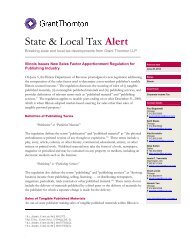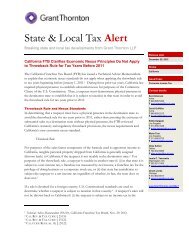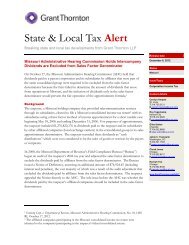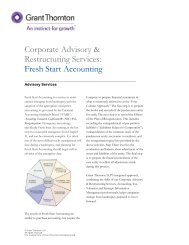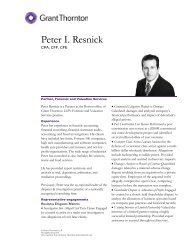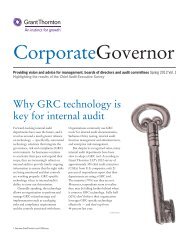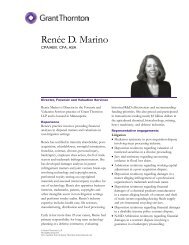Market Structure Redux - Grant Thornton LLP
Market Structure Redux - Grant Thornton LLP
Market Structure Redux - Grant Thornton LLP
You also want an ePaper? Increase the reach of your titles
YUMPU automatically turns print PDFs into web optimized ePapers that Google loves.
cover section<br />
<strong>Market</strong> <strong>Structure</strong> <strong>Redux</strong> I continued<br />
For the Emdeon offering, a total of 23.7 million shares, two<br />
million more than expected, were sold at $15.50 each, the high<br />
end of the expected price range. Underwriters were Morgan Stanley,<br />
Goldman Sachs, UBS and Barclays. While the company which<br />
processed nearly half of all electronic payment claims in the U.S.<br />
last year reported that revenue in the first six months of the year<br />
grew 5 percent to $444 million and net income doubled to $17.8<br />
million, some analysts question whether it can sustain that growth.<br />
Emdeon was trading at $17.21 on Aug. 27.<br />
Starwood Property Trust’s REIT IPO of 40.5 million common<br />
shares priced at $20 per share was the largest IPO in 2009, according<br />
to Renaissance Capital. Sternlicht’s Starwood Capital<br />
Group, a private-equity firm specializing in real-estate investments,<br />
increased its offering from 25 million shares because of<br />
strong demand. Bank of America Merrill Lynch, Deutsche Bank<br />
Securities and Citi were the joint book-runners, and Barclays Capital,<br />
Wells Fargo Securities, Calyon Securities, Cantor Fitzgerald,<br />
Piper Jaffray and Scotia Capital acted as co-managers.<br />
Shares were trading at $ 19.82 on Aug. 27. Many<br />
real estate investment trusts have been raising<br />
funds through secondary stock offerings and<br />
then using proceeds to pay down near-term<br />
debt, according to the National Association<br />
of Real Estate Investment Trusts.<br />
Leibowitz, who denies any impact by<br />
current market structure woes on the<br />
economy, says: “Almost any backer<br />
will tell you if the economy stays here<br />
or gets better, companies will start<br />
coming to market. We had a year and a<br />
half window where everything dried up.<br />
Companies were afraid to go to market<br />
and investors weren’t interested. Now<br />
things are starting to heal and get back<br />
together and the economy is starting<br />
to get significantly better.”<br />
Even small cap IPOs will<br />
come back, says Leibowitz.<br />
“I think ultimately you will<br />
see [small cap company<br />
IPOs]. What you see now<br />
are IPOs of higher quality<br />
companies because people<br />
don’t want to see an IPO<br />
flop now. They want to be<br />
confident in it, so you are<br />
seeing higher quality companies,<br />
and that will start<br />
to broaden out as people feel more confidence in the market,” he<br />
says. “They [higher quality companies] have a better track record,<br />
a better financial position. That is not a judgment on some of the<br />
others. When a banker and owners evaluate ‘Would I come public?’<br />
they want to be sure it’s OK. They want to go find investors who<br />
buy the story, and it’s the value investors who are really active right<br />
now. Value investors want companies with reasonable earnings or<br />
certainly long-term prospects.”<br />
“VCs and private equity both are still in a world of hurt. It’s not<br />
easy to get credit. There’s all sorts of issues involved there. On the<br />
other hand they probably have a bunch of things they own in the<br />
pipeline that they’d like to see go public as soon as things get better.”<br />
The Next Frontier<br />
The constant challenges compel venture capitalists<br />
to always be ahead of the curve, building<br />
new industries rather than chasing trends.<br />
“There is a shift from where we have traditionally invested to<br />
where we will invest. There is a movement away from IT investing<br />
which continues to be very important, but the reality is we are seeing<br />
less of that. Money today is going to life science and exciting<br />
advances in biotech. In five to 10 years, there is going to be a lot of<br />
interest in the clean energy, green tech area,” says Heesen. “You<br />
could see some very exciting companies come out of clean tech<br />
which will excite institutional investors. We see those companies<br />
coming out of this clean tech space. There are many clouds on<br />
horizon, but is this glimmer of hope. Clean tech has the ability<br />
to shake things up. The reason we’re seeing a shrinking number<br />
of companies on Nasdaq and NYSE is because (foreign) companies<br />
are more comfortable to go public on their exchange in their<br />
country. As foreign markets mature, you’re going to see domestic<br />
companies go public on their markets. That’s not a bad thing internationally,<br />
but a damper on the U.S. market.”<br />
There already are signs of growth. Investment in alternativeenergy<br />
companies rebounded in the second quarter, with venturecapital<br />
funding increasing 12 percent from the previous period,<br />
according to consultant firm Cleantech Group and Deloitte Touche<br />
Tohmatsu. The industry isn’t out of the woods yet. The total investment,<br />
spread among 94 companies, was still 44 percent lower<br />
than the $2.15 billion a year earlier.<br />
The clean technology sector, which includes alternative energy,<br />
pollution and recycling, power supplies and conservation,<br />
jumped 15 percent to $274 million in the second quarter from the<br />
first quarter, according to the MoneyTree Report from PricewaterhouseCoopers<br />
and the NVCA, based on data provided by Thomson<br />
12<br />
marketsmedia magazine I september/october 2009




